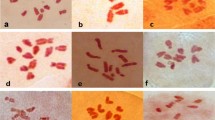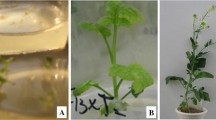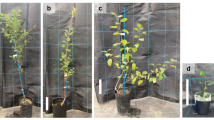Abstract
Camelina (Camelina sativa (L.) Crantz) is a re-emergent oilseed crop that is also becoming important as a model for applied projects based on studies in Arabidopsis thaliana, since the two species are closely related members of the tribe Camelineae of the Brassicaeae. Since camelina can be transformed genetically by floral dip, genetically modified (GM) camelina is being created in many laboratories, and small-scale field trials are already being conducted in the US and Canada. Although camelina does not cross-fertilize Brassica crop species, such as oilseed rape, nothing was known about its ability to cross with other members of the tribe Camelineae, which in addition to arabidopsis includes the widespread weed, shepherd’s purse (Capsella bursa-pastoris). We have tested the ability of camelina to cross with arabidopsis and C. bursa-pastoris, as well as with the more distantly related Cardamine hirsuta, tribe cardamineae. No seeds were produced in crosses with arabidopsis, and a few seeds were obtained in crosses with C. hirsuta, but the embryos aborted at an early stage of development. A few seeds were also obtained in crosses with C. bursa-pastoris, which germinated to produce plants of a phenotype intermediate to that of the parents, but the hybrids were both male and female sterile. Therefore, the likelihood of pollen-mediated gene flow from camelina to these related species is low.




Similar content being viewed by others
References
Bartholmes MA, Nutt P, Theissen G (2008) Germline transformation of shepherd’s purse (Capsella bursa-pastoris) by the ‘floral dip’ method as a tool for evolutionary and developmental biology. Gene 409:11–19
Beilstein MA, Al-Shehbaz IA, Mathews S, Kellogg EA (2006) Brassicaceae phylogeny and trichome evolution. Am J Bot 93:607–619
Beilstein MA, Al-Shehbaz IA, Mathews S, Kellogg EA (2008) Brassicaceae phylogeny inferred from phytochrome A and NDHF sequence data: tribes and trichomes revisited. Am J Bot 95:1307–1327
Bramm A, Dambroth M, Schulte-Korne S (1990) Analysis of yield components of linseed, false flax, and poppy. Landbauforschung Voelkenrode 40:107–114
Carlson T, Bleeker W, Hurka H, Elven R, Brochmann C (2009) Biogeography and phylogeny of Cardamine (Brassicaceae). Ann Missouri Bot Gard 96:215–236
Clough SJ, Bent AF (1998) Floral dip: a simplified method for Agrobacterium-mediated transformation of Arabidopsis thaliana. Plant J 16:735–743
Gehringer A, Friedt W, Lühs W, Snowdon RJ (2006) Genetic mapping of agronomic traits in false flax (Camelina sativa subsp. sativa). Genome 49:1555–1563
Hovsepyan R, Willcox G (2008) The earliest finds of cultivated plants in Armenia: evidence from charred remains and crop processing residues in pisé from the Neolithic settlements of Aratasche and Aknashen. Veg Hist Archeobot 17(suppl. 1):63–71
Hurka H, Friessen N, German DA, Franzke A, Neuffer B (2012) ‘Missing link’ species Capsella orientalis and Capsella thracica elucidate evolution of model plant genus Capsella (Brassicaceae). Mol Ecol 21:1223–1238
Hutcheon C, Ditt RF, Beilstein M, Comai L, Schroeder J, Goldstein E, Shewmaker CK, Nguyen T, De Rocher J, Kiser J (2010) Polyploid genome of Camelina sativa revealed by isolation of fatty acid synthesis genes. BMC Plant Biol 10:233
Kang J, Snapp AR, Lu C (2011) Identification of three genes encoding microsomal oleate desaturases (FAD2) from the oilseed crop Camelina sativa. Plant Physiol Biochem 49:223–229
Lu C, Kang J (2008) Generation of transgenic plants of a potential oilseed crop Camelina sativa by Agrobacterium-mediated transformation. Plant Cell Rep 27:273–278
Marie D, Brown SC (1993) A cytometric exercise in plant DNA histograms, with 2C values for 70 species. Biol Cell 78:41–51
Nguyen T, Collins-Silva JE, Macrander J, Yang W, Nazarenus TJ, Nam J-W, Jaworski JG, Lu C, Scheffler BE, Mockaitis K, Cahoon EB (2013) Camelina seed transcriptome: a tool for meal and oil improvement and translational research. Plant Biotech J. doi: 10.1111/pbi.12068
Sayanova O, Ruiz-Lopez N, Haslam RP, Napier JA (2011) The role of delta-6-desaturase acyl-carrier specificity in the efficient synthesis of long-chain polyunsaturated fatty acids in transgenic plants. Plant Biotech J 11:157–168
Séguin-Swartz G (2008) Hybridization between Camelina sativa (L.) Crantz (false flax) and Brassica napus, B. rapa and B. juncea. Report to the Canadian Food Inspection Agency. July 31, 2008
Séguin-Swartz G, Warwick SI, Gugel RK, Olivier CY, Soroka J, Strelkov SE, Klein-Gebbinck H, Falk KC (2010) Biology of Camelina sativa (L.) Crantz (false flax). Final report to the Canadian Food Inspection Agency. June 7, 2010
Tepfer M, Racovita M, Craig W (2013) Putting problem formulation at the forefront of GMO risk analysis. GM Crops Food 4:1–6
Toulemonde F (2010) Camelina sativa: l’or végétal du Bronze et du Fer. Anthrobotanica 1(1):3–14
Verdaguer B, de Kochki A, Beachy RN, Fauquet C (1996) Isolation and expression in transgenic tobacco and rice plants of the Cassava vein mosaic virus (CVMV) promoter. Plant Mol Biol 31:1129–1139
Walsh KD, Puttick DM, Hills MJ, Yang R-C, Topinka KC, Hall LM (2012) First report of outcrossing rates in camelina (Camelina sativa (L.) Crantz). Can J Plant Sci 92:681–685
Zubr J (1997) Oil-seed crop: Camelina sativa. Ind Crop Prod 6:113–119
Acknowledgments
We thank E. Cahoon for providing pBinGlyRed2, G. Theissen for providing C. bursa-pastoris G4, the CAVAC for providing camelina cv Céline, P. Grillon for growing the plants in the greenhouse, M. Racovita and W. Craig for helpful discussions. This research was supported in part by 3BCAR Institut Carnot project Camelina Oil.
Author information
Authors and Affiliations
Corresponding author
Rights and permissions
About this article
Cite this article
Julié-Galau, S., Bellec, Y., Faure, JD. et al. Evaluation of the potential for interspecific hybridization between Camelina sativa and related wild Brassicaceae in anticipation of field trials of GM camelina. Transgenic Res 23, 67–74 (2014). https://doi.org/10.1007/s11248-013-9722-7
Received:
Accepted:
Published:
Issue Date:
DOI: https://doi.org/10.1007/s11248-013-9722-7




